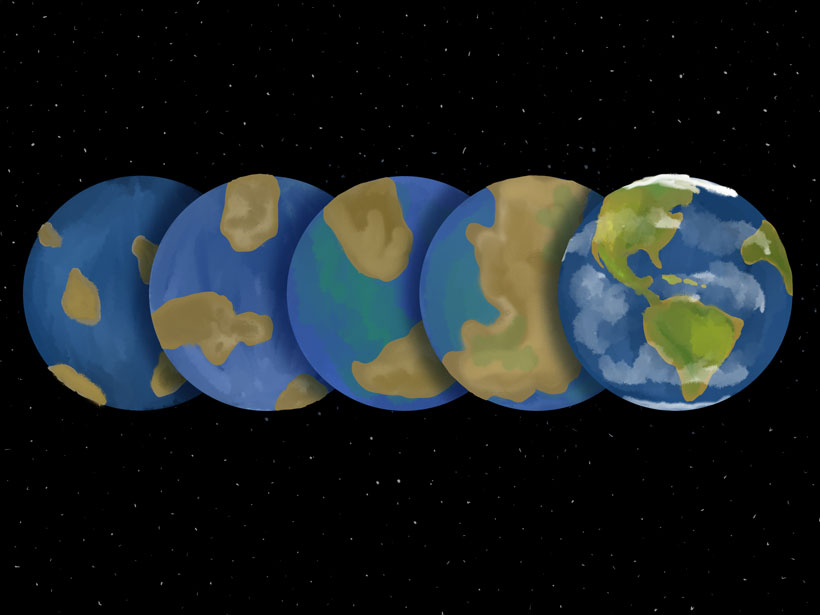The hunt for exoplanets has been remarkably successful. Over 4,000 have been teased out of the vastness of space, a feat that wows even the experts who know how to pull it off.
However, as of 13 April, roughly 4% of exoplanets found are likely terrestrial, meaning only a small fraction of them are similar in size to the rocky inner planets of our solar system, including Earth. Future tools like the James Webb Space Telescope (JWST) and the Extremely Large Telescope (ELT) should allow researchers to resolve these smaller celestial bodies with higher precision. In the meantime, researchers are working to match this future experimental power with similarly strong theoretical tools.
Recently, a team of planetary scientists from the Carl Sagan Institute at Cornell University in Ithaca, N.Y., led by Lisa Kaltenegger, published models of how Earth would have looked to distant observers over its geologic history. The researchers outlined their results in a paper published in the Astrophysical Journal Letters. The data, available online, will allow future telescopes to zero in on signals from Earth-like planets and bring an entire network of as-yet-unknown exoplanets to life.
Spectroscopic Fossils
Ever since Carl Sagan peered back at Earth in the early 1990s through the eyes of Voyager 1, exoplanet researchers have used our home as the ideal reference point for what to look for outside the solar system. Years of scrutiny have yielded detailed atmospheric models and spectra of our modern Earth. But would an exoplanet researcher on another planet in a galaxy far, far away see the same data?
“Even though extrapolations from our findings suggest that one out of five stars hosts a planet which could be like Earth, it would be extremely surprising if all of them were at our Earth’s evolutionary stage.”
“Even though extrapolations from our findings suggest that one out of five stars hosts a planet which could be like Earth, it would be extremely surprising if all of them were at our Earth’s evolutionary stage,” said Kaltenegger. “So taking Earth’s history into account to me is critical to characterize other Earth-like planets.”
Drawing on previous studies of her own and by other researchers, Kaltenegger and her team produced transmission spectra, records of the chemical signatures of a planet’s atmosphere as it passes in front of its star, for five epochs throughout Earth’s geologic history. These epochs represent Earth’s evolution from a prebiotic, low-oxygen, Archean world to an oxygen-rich planet teeming with life.
Earth’s chemical signatures have been in constant flux as land cover, vegetation, temperature, and many more variables have changed over geologic time. Some of these chemicals, most notably oxygen (O2) and methane (CH4), can be used as signs of life, or biosignatures. “This combination of gases is currently our most robust sign of life in a planet’s atmosphere,” Kaltenegger said.
Broadening Other Horizons
Measuring biosignatures like O2 and CH4 in the atmosphere of a rocky exoplanet would be a significant achievement in astronomy. Timothy Lyons, a professor at the University of California, Riverside and a member of the NASA Astrobiology Institute not involved in the new study, leads a research group that studies how detectable certain compounds would have been in the early history of life on Earth. “In many cases, the concentrations may have been too low in the atmosphere—giving rise to the concept of the false negative,” he noted. The opposite concept, in which detected concentrations of O2 and CH4 result from abiotic processes instead of life, is known as false positives.
Another uncertainty, found within the modeled spectra themselves, lies in the relationship between the spectral signatures for CH4 and water (H2O). Zifan Lin, an undergraduate research assistant associated with the study, found significant overlap between these two molecules in the spectra, suggesting that researchers should “beware” that water features they see could partially stem from CH4.
Nevertheless, these difficulties benefit the research community by forcing a certain degree of creativity and flexibility. Jack Madden, a graduate student associated with the study, works on expanding our theoretical models to explore what makes a planet habitable. In addition, Earth-like planets found using these new spectra will broaden our understanding of planetary evolution in new ways.
“I think that finding other planets like ours will give us fascinating insights into how Earth-like planets evolve,” said Kaltenegger.
—Christian Fogerty (@ChristianFoger1), Science Writer
Citation:
Fogerty, C. (2020), Looking back at our pale blue dot, Eos, 101, https://doi.org/10.1029/2020EO142957. Published on 23 April 2020.
Text © 2020. The authors. CC BY-NC-ND 3.0
Except where otherwise noted, images are subject to copyright. Any reuse without express permission from the copyright owner is prohibited.

